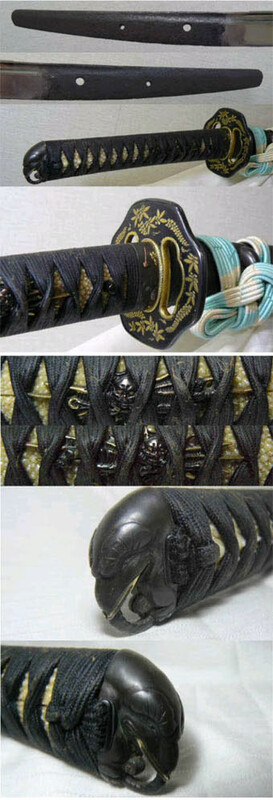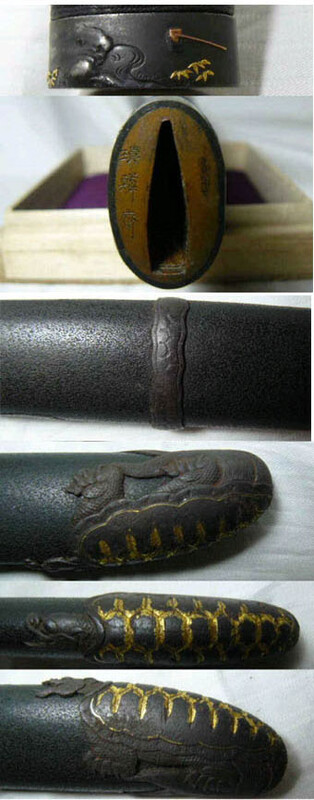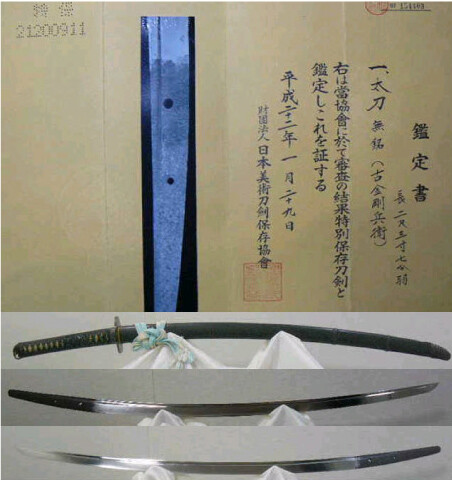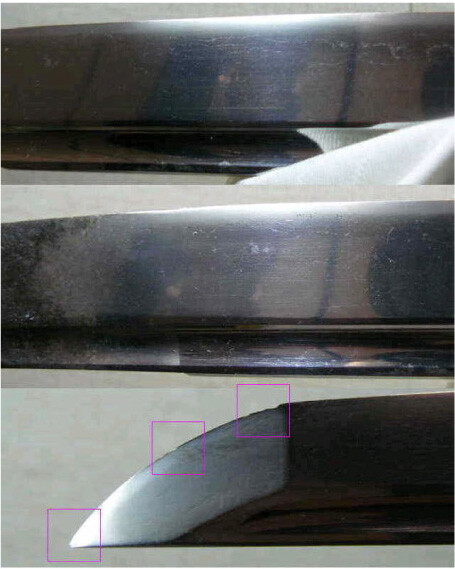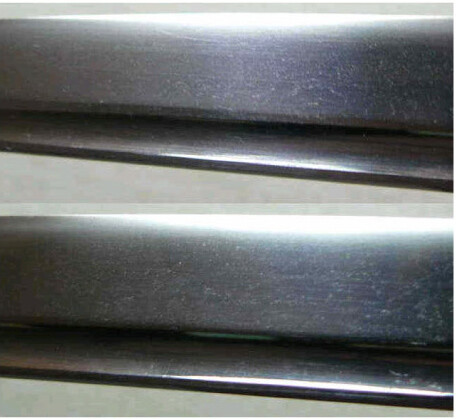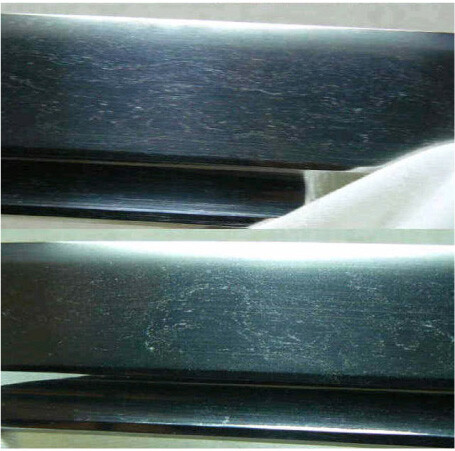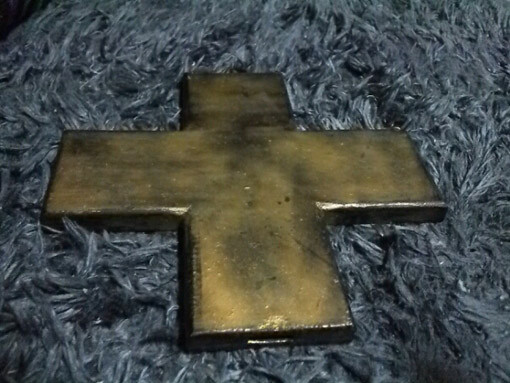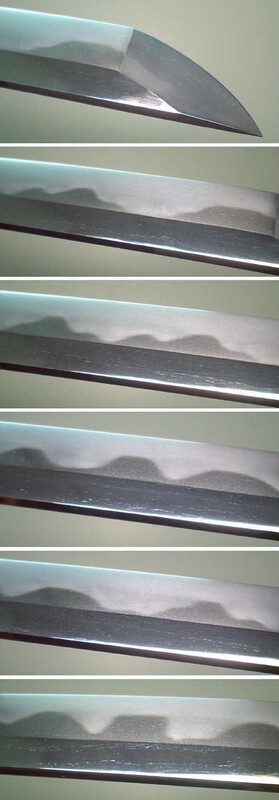-
Posts
341 -
Joined
-
Last visited
Content Type
Profiles
Forums
Events
Store
Downloads
Gallery
Everything posted by leo
-
It is a Kaigunto(naval military sword). Looks like a stainless steel blade, not traditionally made, but closeups from blade and a picture of the whole tang would help. If you open the leather cover carefully, there might be the original saya underneath, either shark skin or black laquer. Martin
-
Jean, this is an interesting nakago, good looking but seems well worked over at earlier times. There is a kind of welding seam near the plugged mekugi ana. If we assume that this is the original hole, then the nagasa must have been at least 80cm. Imho it had been even longer. Now, Guido, my question: Is the term kodachi used for blades originally forged as a short blade only or does it also apply for long tachi blades shortened early to be used as a kodachi? Best, Martin
-
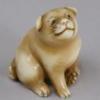
English Index for Nihonto Jiten by Tokuno Kazuo
leo replied to Uechi's topic in General Nihonto Related Discussion
Hi, Jeff, sorry for the English version of my site. Due to lack of time I have not updated it yet. I have the Nihonto Jiten index, though. I have already extracted most of Greys index of sword literature. For all books on my site http://www.juwelier-strebel.de/asien-ku ... echer.html , marked with a star, I have an index available. I do not sell these anyway, but will send them free of charge to NMB members. Just pm me your regular e-mail and I´ll send it to you. Cheers, Martin -

Opinions On My Antique Sword-Kamakura Kodachi
leo replied to ancientnoob's topic in General Nihonto Related Discussion
Nathan, did I miss a picture? I only see a blurred nakago with "Kuni..something". Where is the 6-character-Sukekane-mei? Martin -
Ed, it is a falcon, not an eagle. Cheers, Martin
-
Dear S, the signature had been scratched in by somebody who attempted to imitate a mei. The nakago looks kind of worked over, too. The blade indeed looks somewhat older than Showa. Nevertheless it is in my opinion beyond repair. If it was, it would not be worth the cost of repair, even if you got the blade for free. If you also have the original Showa saya, it would make a nice historical wallhanger and that´s it. Best, Martin
-

Calling Kongobei school sword owners!
leo replied to flemming's topic in General Nihonto Related Discussion
Here is a sword I had a while ago: "TACHI, 71,6cm, shinogi zukuri, bo-hi, sori 2,3cm, motohaba 3,10 cm, kasane: 6,0mm, itame-masame hada with ji-nie and utsuri, komaru boshi, suguha hamon with kinsuji, sunagashi and ashi, suriage nakago, 2 mekugi ana, mumei, attributed to: "KO KONGOBYOE" by NBTHK Tokubetsu-Hozon-Paper, old polish, some chips on boshi, Chikuzen-Provinz, Kamakura-period, in shirasaya." I enclose pictures of blade and koshirae, but the photos of the blade as well as the polish are medium quality at best. I still find it interesting because it is a very early example of this school. Might even be from the period of good old Moritaka. Best, Martin(leo) -
If you are referring to shinae in the mune, I think they are rather produced by "straightening" than by "bending", because most blades have a sori. I think in this case the expression is wrong because "bending" implies that somebody "bends" a blade downwards until shinae appear on the mune. I cannot imagine anybody doing this. It is rather a result of improper heat treatment. This is part of a thread about shinae and hagire posted here before: "Usually this happens when the blade straightens itself due to(unwanted) stress relief. When a blade is tempered, it bends upward and a lot of structural stress is built up. This is usually relieved afterwards by a low- temperature heat treatment. If this is not done accurately or not at all, there will remain unhealthy tension. Depending whether this is towards yakiba or towards mune, there will be hagire or shinae. Unfortunately these not always appear immediately, because then the blade would be scrapped. These cracks usually show after centuries of use and repeated polishings, when the thickness is reduced and the structure thus weakened." Best,
-
"Feeding on the Bottom of the Bin" . Did not know that one, Chris. Hits the point though. I get mails and pictures all the time, which is ok., if it weren´t for the countless pictures of fakes. Unfortunately some of these people are completely immune to advice and think they will find a picasso in the attic(or on Ebay) Now I lean towards sending them a link to the NMB. Luckily there are quite a few who are infected by the Nihonto virus, even through a cheap, but genuine sword and will eventually develop into serious collectors. Best
-
-
A very unconcealed maedate, the carrier did not live very long, I assume. (but maybe not antique). This is in an auction on yahoo. Best,
-
Hi, Branson, "Yamashiro" is also an option, as this tradition worked throughout the Edo period. In connection with the tanago-bara this might be the least dangerous definition as most of these schools also worked in other styles and many works had little to do with the original Koto Yamashiro tradition. A good bet stylewise would be Hizen, as this school liked to copy Koto Yamashiro smiths. The slight tanago-bara shape could have been added for fun or in the process of a severe shortening from a much longer Katana. If you sell it on Ebay or elsewhere, the description should include a big "maybe" or "could be" anyway , unless an expert gives you a precise kantei. Best,
-
Signature is meaningless, blade and saya are non-Japanese scrap. Only the tsuka is original gunto. There is little use to ask questions about this item. Better study the many links on this page(Fake Swords, Kanji Pages) and compare! Best,
-
Thank you, some interesting contributions! Again it seems that if there is one rule, it is that there is none. Off course the sometimes calligraphic flow of a signature should not be interrupted by an irregular spacing, but a hole in the middle of a kanji is not very attractive either. So I guess, even it it was rather unusual to avoid the mekugi ana, there was probably no law against signing a nakago after the ana was punched! Best,
-
There are quite a few reasons why the western definition of a generation, which is simply an assumed cycle of reproduction, cannot be compared to the sometimes complicated Japanese succession system within the smith´s school and/or family. Best,
-
The kitae ware in this position..., its a pity, such a beautiful blade. Maybe the 2 bodies were one too much
-
Thank you, Grey. This is the perfect example! If now I would find such a piece with a Hozon or NTHK Paper or a confirmation that such a thing is nonexistant, I would be completely satisfied. Best,
-
Merci, Jean, I´ll give it a try. Best,
-

Help translating Mei on gunto Katana.... Thank you :)
leo replied to max_levy's topic in Translation Assistance
See this thread: viewtopic.php?f=15&t=10430 Moriyama-San and others translated it already: Seki ju Hoshiya Yoshinaga -
Dear All, there is one thing that bothered me for a while, as I have seen it now and then: Has anybody seen a mei which deliberately was applied by the smith in order to leave room for a mekugi ana? I am not talking about katana where there is enough space above the first kanji to place the ana appropriately. I have seen this on small nakago of tanto or wakizashi where the nakago hardly supplied room for a long mei. Where there any smiths who signed their blades after making the mekugi ana leaving a larger space between 2 kanji in order not to hurt the signature? I am aware that most of such swords are gimei as the signature was added later, but where there exceptions anybody know of? Best,
-

Beginner looking to make his first mail purchase
leo replied to Adrian's topic in General Nihonto Related Discussion
Adrian, with all the dealer links Brian published above, plus the For Sale section, you should be able(requires some amount of precious time though), to scan through the prices being asked for what you desire. If the market does not meet your budget, which is unfortunately rather the rule than the exception , even the most helpful members of this board will not be able to help you. You might try on ebay wth all the risks involved, or wait for a lucky streak. Best, -
Dear Roy, would be easier with a picture of the nakago. It does not seem to be Nobuyoshi III. The mei of the various generations are not so difficult to distinguish. When we are talking about Nobuyoshi III, which is the one from the Christie´s auction, some info: "The smiths of the Takai family are considered to be Yamashiro-Mishina-school, though they developed their own style which with many blades reminds us of Shinkai and Sukehiro. Known are 5 generations of Takai Nobuyoshi, shodai(I), nidai(II) und Nobuyoshi III.(It is not exactly known wether he is the 3rd son of the shodai or one of his younger brothers). After him came generations IV und V. Rai Nobuyoshi was by far the best of the Takai-family. He was active from about 1655 to 1703. Signatures and workmanship show pretty exactly when they were made. On earlier works before 1670 the 16-petal chrysanthemum was chiseled in, while later it was engraved. The name "Rai" was not added before 1673. From 1688 frequently an "Ichi" was added under the kiku mon. Most swords, the earlier works in particular, were made with suguha, while a lot of later blades show the beautiful Toran Midare Hamon in the style of Sukehiro. Though he was active for 50 years, his best works date between 1670 and 1700." One of the German board members owns a Hozon papered katana made by this smith which was discussed here last year. Best,
-
Very reasonable statement, Chris. I might add that for overseas customers like myself, who are not constantly travelling to Japan, the situation might be this: I have bought a polished katana for a rather low price because it had no papers and I send it to Japan to be papered. I have invested in shipping, insurance, import/export shinsa plus handling charges for a local agent anyway. Against all positive judgement the blade was pink slipped solely for gimei(no other problems like saiha, or fatal faults). I would in this case prefer to additionally invest in a mei removal and another shinsa fee. As other members have already mentioned the situation is not always as clear as that. It will get complicated if ....the blade is in need of a better polish ....it is a wakizashi(mei removal and paper is almost the same price, but market value much lower than for a comparable katana) In these cases I would probably decide against the mei removal. This is just one example. Like other members have stated, there are plenty of variations to this, which have to be handled individually. The best way to avoid a mei removal: Make good pictures and get as many professional opinions as possible before you send a blade to Japan. Best,
-
-
Tony, from what I can see, the hamon looks typical. When I am back home I will send some blade pics from my polished Kiju, so you will have an idea what it will look like. Best,


